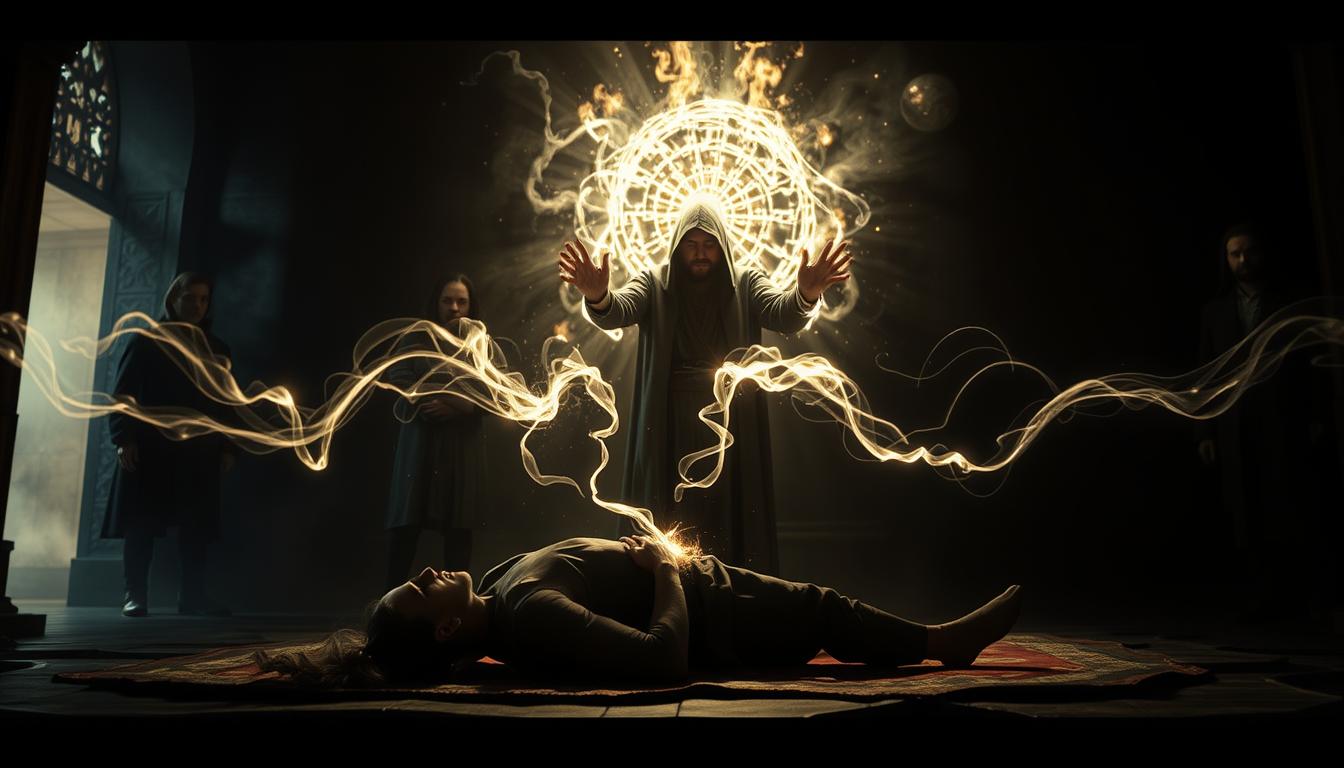Life Transference 5e: A Powerful Ability
Ever wondered if sacrificing your own vitality could turn the tide in battle? Life Transference is one of the most daring spells in Dungeons & Dragons 5e, letting you trade your hit points to heal an ally—twice as much as you lose. It’s a high-risk, high-reward move that sparks debates among players. Is it worth the gamble?

This 3rd-level necromancy spell, available to clerics and wizards, flips traditional healing on its head. Instead of relying on spell slots alone, you exchange your HP to save a teammate. The math is simple: lose 10 health, and they gain 20. But is it smarter than casting Cure Wounds? That’s where strategy comes in.
In this guide, I’ll break down how Life Transference works, when to use it, and clever ways to maximize its potential. Whether you’re a healer or a tactician, this spell offers surprises—if you’re bold enough to try it.
Key Takeaways
- Sacrifice your HP to heal allies for double the amount.
- Available as a 3rd-level necromancy spell for clerics and wizards.
- High-risk but rewarding in clutch moments.
- Outperforms Cure Wounds in specific scenarios.
- Requires careful timing and positioning.
What Is Life Transference 5e?
Some spells demand sacrifice—this one rewards it. Life Transference lets you trade your vitality to heal another, but mastering it requires understanding its gritty details.
Spell Basics and Description
This 3rd-level necromancy spell needs verbal and somatic components. It takes one action to cast and works within 30 feet. You take 4d8 necrotic damage, and a creature you choose regains twice that amount.
Can you target yourself? Rules as written, no. The spell specifies “a creature you can see within range”—not “you.” Some DMs allow it, but RAW favors teamwork.
On average, 4d8 deals 18 damage to you and 36 healing to allies. That’s double the output of Cure Wounds, but riskier. Necromancy’s theme—shifting energy—fits perfectly here.
Oddly, it doesn’t need concentration despite the lingering debate. The effect is instant, so no ongoing checks are required.
How Life Transference 5e Works
Few spells flip the script on healing like this risky maneuver. It’s not just about casting—it’s a calculated gamble where every point of damage you take becomes a lifeline for allies.
Damage and Healing Mechanics
Roll 4d8 necrotic damage against yourself. The creature you choose regains double that amount. Simple math, but timing matters. The damage hits you first, then the healing kicks in.
Resistance or immunity? It won’t reduce your loss. The spell’s wording ignores modifiers, making it a raw deal. Average rolls mean 18 HP lost for 36 HP gained—outpacing Cure Wounds at higher levels.
Targeting Rules: Can You Cast It on Yourself?
RAW says no. The spell specifies “a creature you can see within range,” excluding you. Some DMs allow it, but it’s risky. Dropping to 0 HP triggers death saves before the healing applies.
Line of sight is key. No peeking around corners—your target must be visible. Hidden allies? Save the spell for another turn.
Why Use Life Transference?
What if you could turn your pain into someone else’s gain? This spell isn’t just about healing—it’s a tactical trade-off. At 3rd level, it outperforms Cure Wounds in raw output but demands courage. Here’s when to embrace the risk.

When to Cast It in Combat
Timing is everything. Use it when:
- A frontliner is down, and their next hit could mean death.
- Your character has high CON or temp HP to absorb the blow.
- The party’s cleric is out of slots, but you’ve got reserves.
Strategic Advantages Over Cure Wounds
This spell trades your HP for double healing. Compare it to common alternatives:
| Spell | Slot Efficiency | Risk | Best For |
|---|---|---|---|
| Life Transference | 36 HP avg. (3rd-level) | High (self-damage) | Clutch saves |
| Cure Wounds | 13.5 HP avg. (3rd-level) | None | Sustained recovery |
Action economy matters too. Unlike bonus-action heals, this costs a full turn—so make it count. Pair it with a rogue’s evasion or a barbarian’s rage to maximize value.
Maximizing Healing with Life Transference
Sorcerers have a secret weapon to amplify Life Transference. With metamagic, this spell goes from risky to revolutionary. Here’s how to push its limits.
Doubling Down: Twinning the Spell
Twinned Spell lets you target two allies at once. Cast Life Transference, and both get healed for double your damage. The math? 8d8 to you (avg. 36 HP lost), but 16d8 healing split between them (72 HP total).
Only Divine Soul sorcerers get this combo naturally. At level 5, you’d spend 3 sorcery points—worth it to save two frontliners. Just don’t drop below 36 HP yourself.
Empowered Spell Metamagic
Reroll low damage dice with this trick. If your 4d8 rolls a 1 and two 2s, spend 1 sorcery point to try again. Higher damage to you means bigger heals for allies.
Pair it with Twinned Spell for insane value. Example:
- Roll 4d8: 5, 3, 2, 1 → Reroll the 1 and 2.
- New rolls: 6 + 4 → Total 20 damage (40 healing).
This spell isn’t just a last resort—it’s a way to outheal clerics when mastered.
Class Synergies for Life Transference
Some classes turn this risky spell into a powerhouse. While wizards and clerics get it baseline, others twist its rules for insane value. Here’s how to pair it with divine magic and metamagic for maximum impact.
Divine Soul Sorcerer Combos
Twinned Spell is the crown jewel. Target two allies instead of one, doubling the spell’s output. Example:
- You take 4d8 damage (avg. 18 HP lost).
- Two allies gain 36 HP healing total.
Pair it with Empowered Spell to reroll low necrotic rolls. At 5th level, this combo saves frontliners better than most cleric spells.
Grave Cleric’s Vulnerability Trick
Path to the Grave (Grave Cleric 2) makes the next attack deal double damage. Surprise twist: it works on life transference’s self-harm. Here’s the math:
| Scenario | Your Loss | Ally’s Gain |
|---|---|---|
| Normal Cast | 18 HP | 36 HP |
| With Vulnerability | 36 HP | 72 HP |
Risky? Absolutely. But a barbarian at 1 HP won’t complain.
Life Cleric’s Bonus Healing
Disciple of Life (Life Cleric 1) adds +5 to any healing spell. Since life transference restores HP, it qualifies. Breakdown:
- Base: 18 HP lost → 36 HP healed.
- With Disciple: 36 + 5 = 41 HP.
Multiclass with sorcerer for Twinned Spell, and you’ve got a 82 HP swing for one slot. Just don’t forget CON saves—losing 36 HP mid-fight hurts.
Creative Exploits and Loopholes
Temp HP and magic items turn this risky spell into a tactical masterpiece. While life transference seems straightforward, clever players twist its rules to avoid damage or delegate the cost. Here’s how to game the system—without angering your DM.
Using Temporary HP to Offset Damage
Twilight Clerics are the ultimate enablers. Their Channel Divinity: Twilight Sanctuary grants allies temp HP every round. Cast life transference while shielded, and the necrotic damage hits your buffer first. Example:
- You have 10 temp HP from Channel Divinity.
- Roll 4d8: 15 necrotic. Temp HP absorbs 10, leaving only 5 real HP lost.
- Your target still gains 30 healing—half the risk, full reward.
Heroism and Inspiring Leader work too. Just time it before combat peaks.
Ring of Spell Storing Shenanigans
Store life transference in the ring, then hand it to a familiar or summoned creature. They cast it, but you aren’t the one taking damage. RAW, this works—but DMs may veto it. For best results:
- Use Planar Binding on a Celestial to spam heals safely.
- Imps and Pseudodragons make disposable spell batteries.
- Artificer’s Spell-Refueling Ring recovers slots for repeat casts.
Warning: Some DMs rule the ring’s caster (you) still suffers the damage. Always ask first. If allowed, it’s the safest way to exploit this spell.
Necrotic Damage Amplification
Not all damage is created equal—certain abilities supercharge necrotic output. When casting life transference, some racial traits and class features can twist the spell’s self-harm into greater rewards. Here’s how to weaponize your suffering.

Fallen Aasimar’s Necrotic Shroud
Fallen Aasimar add their proficiency bonus to necrotic damage rolls. At level 5, that’s +3 extra damage to yourself—but your ally gains double that value. The math gets wild:
| Level | Your Loss | Ally’s Gain |
|---|---|---|
| 5 | 21 HP (18+3) | 42 HP |
| 9 | 22 HP (18+4) | 44 HP |
Pair this with resistance (like a Bear Totem Barbarian multiclass) to mitigate the extra pain. Just remember—the bonus applies once per turn, not per die.
Hexblade’s Critical Cheese
A Hexblade’s Curse (1st level) boosts crit chance on 19-20. Normally useless for spells, but life transference’s damage roll can crit! Here’s why it matters:
- Crit doubles your 4d8 damage (avg 36 instead of 18).
- Ally gains 72 HP—equivalent to a 6th-level Cure Wounds.
- Works best with Advantage (Elven Accuracy feat).
Warning: This burns your bonus action to set up. Weigh it against twinning the spell for multi-target heals.
Metamagic and Life Transference
Metamagic can turn a risky spell into a game-changer—here’s how. Whether you’re an evoker maximizing output or a sorcerer bending rules, these tricks redefine life transference’s potential.
Twinned Spell: RAW vs. RAI Debates
Twinning this spell is controversial. RAW says yes—it targets one creature, not you. But Jeremy Crawford’s RAI tweets suggest self-damage disqualifies it. Practical table solutions:
- Allow it: Twin for double healing (36 HP lost → 72 HP gained).
- Ban it: Avoids Nova-healing imbalance.
- Compromise: Twin at higher sorcery point cost.
Maximized Spell (Evoker’s Overchannel)
Evokers at level 14 unlock Overchannel, guaranteeing max damage. For life transference, that’s 32 HP lost and 64 HP healed—no rolls needed. Pair it with:
- Empowered Spell: Reroll low necrotic rolls pre-Overchannel.
- Draconic Bloodline: +CHA to necrotic damage (if chosen).
| Metamagic | Your Loss | Ally’s Gain |
|---|---|---|
| None | 18 HP (avg) | 36 HP |
| Overchannel | 32 HP | 64 HP |
| Twinned + Overchannel | 32 HP | 128 HP (two targets) |
Warning: Overchannel’s cumulative damage limits frequent use. Save it for boss fights where a 64 HP swing matters.
Multiclassing for Optimal Use
Multiclassing unlocks hidden potential in spells—this one’s no exception. By blending classes, you can mitigate risks or amplify rewards. Here’s how to engineer your character for maximum impact.
Sorcerer/Cleric Hybrids
Divine Soul sorcerers gain cleric spells naturally. Pair this with Life Cleric 1 for Disciple of Life, adding +5 to all heals. The math gets wild:
| Class Combo | Your Loss | Ally’s Gain |
|---|---|---|
| Divine Soul 5 | 18 HP | 36 HP |
| + Life Cleric 1 | 18 HP | 41 HP |
Slot progression stays smooth. At level 6 (Sorcerer 5/Cleric 1), you’ll have four 1st-level slots and two 3rd-level slots—perfect for spamming heals.
Coffeelock Potential
This infamous Sorcerer/Warlock build abuses Pact Magic. Convert warlock slots to sorcery points, then to spell slots. Key steps:
- Take 2+ levels in Warlock (Hexblade for armor proficiency).
- Use Aspect of the Moon invocation to skip long rests.
- Stockpile slots indefinitely—until exhaustion hits.
Warning: DMs often ban this. Even if allowed, track exhaustion. At six levels, your character dies.
Theurgy Wizard Alternative
Wizards with the Theurgy arcane tradition can steal cleric spells. At level 2, pick Life Domain for Disciple of Life. Unlike sorcerers, you’ll:
- Lose metamagic but gain ritual casting.
- Access wizard utility spells like False Life for temp HP buffers.
- Scale slower—your first 3rd-level slot comes at level 5.
Mitigating the Risks
Risk management separates reckless casters from tactical healers. Life transference deals hefty damage to you—so plan ahead. Here’s how to avoid KO’ing yourself while saving allies.
Concentration Checks and Warcaster
If you’re concentrating on another spell, losing HP forces a CON save. At 18 damage, the DC is typically 9 (10 + half taken). Odds aren’t great without help:
| CON Save Bonus | Success Rate | With Bless/Warcaster |
|---|---|---|
| +2 | 60% | 80% |
| +5 | 85% | 97% |
Warcaster grants Advantage on saves. Pair it with Bless for near-guaranteed success. Sorcerers can twin Bless to protect two allies—and yourself.
Death Ward as a Safety Net
This 4th-level healing spell prevents KO when you hit 0 HP. Cast it before life transference to avoid death saves. Key notes:
- Lasts 8 hours—pre-cast it before dungeons.
- Stacks with Periapt of Wound Closure (stabilizes you automatically).
- Combos with Aid to boost max HP preemptively.
If all else fails, keep a Healing Potion handy. Chug it right after casting—just in case.
Party Combo Potential
Teamwork makes the dream work—especially with this spell’s risky mechanics. Alone, it’s a gamble. With allies, it becomes a powerhouse. Here’s how class features amplify or sabotage its effects.
Unicorn Spirit (Shepherd Druid)
At level 5, a Shepherd Druid’s Unicorn Spirit adds +11 to all healing within its aura. Cast Life Transference inside it, and the math shifts:
- You lose 18 HP (4d8 average).
- Ally gains 36 HP + 11 = 47 HP.
The aura affects all creatures in 30 feet—perfect for group fights. Just stay close to your druid.

Abjuration Wizard’s Ward (Why It Fails)
Abjuration Wizards absorb damage with their Arcane Ward. Sounds great, right? Wrong. The ward eats the necrotic hit, but the healing is based on the original roll. Example:
- Roll 4d8: 20 damage → Ward takes 20.
- Ally heals 40 HP, but you lose nothing.
- Next cast? Ward breaks, and you’re suddenly vulnerable.
It’s a short-term trick with long-term risks.
Twilight Cleric’s Shared Temp HP
Their Channel Divinity grants temp HP every round. Use it before casting:
- You have 10 temp HP.
- Take 15 damage → 5 real HP lost.
- Ally still gains 30 HP.
Bonus: The cleric’s aura also prevents charm/fear effects mid-cast.
Celestial Warlock’s Healing Light
Pair this spell with their bonus-action Healing Light. After transferring HP, spend dice to patch yourself up. At level 5, you’ve got 3d6 to offset losses.
Order Domain’s Voice of Authority
When you heal an ally, they can immediately attack. Perfect for rogues needing sneak attack triggers. Just don’t expect double turns—the feature limits reactions.
DM Pitfalls and Rule Clarifications
Rules debates can make or break this spell’s power at your table. While Life Transference seems simple, DMs often clash over its finer points. I’ve seen campaigns derailed by unclear rulings—here’s how to avoid the drama.
Common House Rules to Watch For
Many tables tweak how this spell works. Popular changes include:
- Self-targeting bans: RAW, you can’t cast it on yourself. Some DMs allow it, but it risks instant KO.
- Twinning nerfs: Sorcerers love twinning it, but many DMs ban this combo for balance.
- Damage type swaps: Necrotic too harsh? Some let you take radiant or force damage instead.
Sage Advice and Official Rulings
Jeremy Crawford’s tweets clarify key confusion points:
- Temp HP doesn’t reduce healing: Even if your buffer absorbs the damage, allies still heal based on the full roll.
- No twinning: The spell “affects multiple creatures” (you + target), breaking Twinned Spell’s rules.
- Targeting limits: Must see the creature—no blind or invisible heals.
Adventurers League adds stricter limits. Print this cheat sheet for your DM:
- AL bans self-casting and twinning outright.
- No multiclass shenanigans (e.g., Coffeelock exploits).
- All Life Transference casts must be declared before rolling.
Life Transference in Action
Seeing this spell work in battle changes everything. Theory is one thing—watching a near-death ally spring back with double your sacrifice is another. Let’s break down real combat applications and record-breaking heals.
Example Combat Scenarios
A level 5 Divine Soul Sorcerer can turn the tide with one bold move. Here’s how:
- Race: Fallen Aasimar adds +3 necrotic damage (proficiency bonus).
- Setup: Bonus action activates Necrotic Shroud.
- Cast: Twinned Life Transference on two allies.
The math gets wild:
| Component | Your Loss | Total Healing |
|---|---|---|
| Base (4d8) | 18 HP | 36 HP per ally |
| + Necrotic Shroud | 21 HP | 42 HP per ally |
| Twin Spell | 21 HP | 84 HP total |
One-Turn Healing Records
The highest recorded heal? 148 HP at level 5. Here’s how:
- Grave Cleric applies Path to the Grave (vulnerability).
- Fallen Aasimar sorcerer twins the spell.
- Roll max damage (32 HP x2 vulnerability = 64 HP lost).
- Allies gain 128 HP + 20 from Necrotic Shroud.
Compare this to a 6th-level Heal (70 HP to one target). The numbers speak for themselves.
Alternative Uses Beyond Healing
Who says healing is the only trick up this spell’s sleeve? While Life Transference shines in clutch saves, clever players weaponize its necrotic bite for deception, interrogation, and even psychological warfare. Here’s how to flip the script.
Deception with Illusory Script
Forge a scroll of Life Transference using Illusory Script. To an enemy caster, it seems harmless—until they attempt to cast it. The damage triggers, but the healing fails (since the spell’s effects are fake).
Pair it with Nystul’s Magic Aura to mask the forgery. A disguised “healing scroll” becomes a Trojan horse. Just ensure your DM allows creative item interactions.
Baiting Enemy Casters
Pretend to cast this spell on a downed ally. Enemy casters might burn Counterspell to stop the heal—only to realize you faked the somatic components. Now they’re out a slot, and your real healer acts freely.
Pro Tip: Use Zone of Truth interrogations. Offer to “heal” a captive if they talk. The creature sees you take damage, selling the lie. Even if they resist, the bluff plants doubt.
- Plot Device: NPCs might use this spell to fake martyrdom or extort favors.
- Rule of Cool: Some DMs allow cursed variants—like healing enemies but harming allies.
Frequently Overlooked Tricks
Even seasoned players miss these game-changing tricks. While most focus on basic life transference combos, high-level features and creative reflavoring unlock next-level potential.
Improved Reaper (Death Cleric 17)
At level 17, Death Clerics gain Improved Reaper, letting them target two creatures with necromancy spells. This includes our risky spell—with explosive results.
Here’s the math at peak performance:
- Base cast: 32 damage to you (4d8 max roll)
- Two allies gain 64 HP each → 128 total healing
- Add Path to the Grave vulnerability for 256 HP output
Warning: This burns half your HP at higher levels. Keep Death Ward ready.
Draconic Sorcerer Homebrew Flavor
Shadow Dragon sorcerers often reflavor the spell as vampiric essence transfer. The black tendrils visual fits better than default radiant energy. Some DMs allow:
- Swapping necrotic for cold damage (Gem Dragonmark synergy)
- Adding dragon wings animation during casting
- Changing verbal components to Draconic phrases
For Eberron games, the Mark of Healing halfling’s extra healing dice can stack with this spell. Always check with your DM first—these tweaks vary by table.
Conclusion: Mastering Life Transference 5e
Mastering this spell means walking the line between heroism and recklessness. Whether you’re twinning it for double healing or offsetting damage with temp HP, strategy trumps brute force.
Remember: timing saves lives. Cast it too early, and you’re vulnerable. Too late, and it’s wasted. Experiment with multiclass combos—Grave Clerics and Divine Souls shine here.
Your table’s rules might tweak its power. Always clarify twinning or self-targeting first. Now go bend the rules—just don’t break your character doing it.